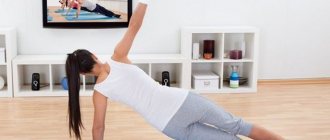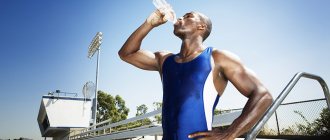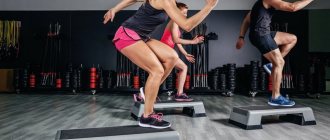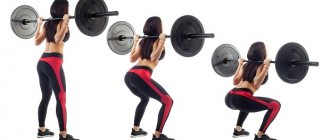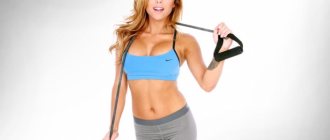Women's fitness is a very tough sport that requires participants to have outstanding gymnastic training. Suffice it to say that the participants in fitness tournaments should all be able to perform somersaults, easily do the splits and do push-ups on one hand. It is clear that it is difficult for a simple fitness enthusiast, busy with children and work, to grow to a competitive level due to the inevitable lack of time for hours of training. The International Federation of Bodybuilding (IFBB), under whose wing world fitness is developing, made a fundamental decision to simplify the competition rules for women and created a new type of competition - body fitness.
If fitness didn't exist, it would have to be invented. The mere appearance of long-legged beauties on stage delights the audience, let alone free compositions in which girls dressed in theatrical costumes try to demonstrate themselves in full splendor.
Body fitness competition
The conditions for holding competitions in body fitness (sometimes also called figuring) are very democratic and allow the participation of women who have been involved in fitness for no more than six months. From the outside it may seem that this is just a beauty contest among female athletes. Moreover, the competition participants go on stage in swimsuits and high heels.
Here is a specific quote from the competition rules: “The judges evaluate the overall athleticism of the physique, taking into account the entire physical development of the participant. Facial attractiveness and hairstyle, athletic proportionality, artistry and grace are also assessed. The assessment takes into account skin density and tone. The skin should be healthy and smooth, without signs of cellulite...
Body composition is assessed by the level of muscle tone achieved through strength training. The muscles should be dense and elastic, with a minimum amount of fat. The physique should not be overly muscular, venousness and deep muscle “drawing” are excluded. Participants with excessive muscles, as well as an unathletic body, are placed in last place... “.
https://youtu.be/Rh-VTVZd3gM
- WOMEN'S FITNESS
- FREE PROGRAM
- THE FINAL
- MEN'S FITNESS
- GENERAL REQUIREMENTS FOR DEVELOPING A FREE PROGRAM FOR WOMEN'S AND MEN'S FITNESS
- BODY FITNESS
COMPETITION RULES OF THE INTERNATIONAL FEDERATION OF BODYBUILDING (IFBB) AND THE FEDERATION OF BODYBUILDING AND FITNESS OF RUSSIA (FBFR)
WOMEN'S FITNESS
Each sport has its own characteristics of performing a motor action, determined by its target orientation, external conditions and competition rules, which determine the specific requirements for the athlete’s preparedness.
Based on the rules of bodybuilding and fitness competitions under the IFBB, the composition should consist of 1-2 parts, each of which lasts 30 seconds, the composition time is 1 minute. During this time, the athlete must reveal all her abilities, demonstrate elements of strength, flexibility, jumping, and also demonstrate her artistic abilities, i.e., reflect the intended image with specific plastic movements and the manner of performing the chosen style of music (oriental, Spanish, Russian, jazz, modern, break, etc.). There are no mandatory elements in the competition rules - the athlete has the right to choose elements that are available according to her level of training, achieve precise execution and include them in the program. Do not forget that uncertain execution of elements can affect the impression of the composition. Poorly prepared novice athletes, due to concentration on complex elements, forget about presentation (artistry), which significantly affects the effectiveness of the performance, the audience’s reaction and the judges’ assessment. Often the following errors can be seen in the composition :
– unbalanced program (i.e. passion for dance or strength elements);
– the chosen style of music does not correspond to the plasticity of movements;
– the selected angles of movements do not correspond to their visual perception.
Original musical material, a large supply of motor and strength training, good flexibility enable the trainer-choreographer to choose an image, style and balance the distribution of elements in each of the 2-3 parts of the composition. When posing, it is very important to take into account the individual style and errors in the athlete’s figure. The task of the choreographer is to be able to hide flaws with the help of movements and emphasize her positive qualities and body proportions. The elements should organically merge with the intended image and emphasize the musical accents of the chosen work.
I would like to remind the coach that any element performed must be shown to the judges from the angle in which it is best viewed. For example, sideways to the spectator should be performed: front balance, bridge, flips forward, backward, to the side (wheel), flexion, extension of arms in a prone position, however, lateral bending of one or both arms in a prone position should be performed facing the judges. If an athlete does not have the necessary flexibility, her range of motion is limited - of course, it is not advisable to include swings, etc. in the composition, therefore it is necessary to select movements with the position of bent legs, focus on the performance of power elements or on the artistic abilities of the athlete .
In order to more clearly reflect the athlete’s existing abilities, it is advisable to include 2-3 elements from each main group in the composition, i.e. elements of static, dynamic strength, elements of flexibility, jumps.
Particular attention should be paid to the selection of musical material.
As a rule, those compositions where the music is recognizable, popular and incendiary are successful. By changing the musical material and image in each part, a performing athlete can make a greater impression on judges and spectators than an athlete performing to the accompaniment of one melody. Of no small importance is the quality of the composition of the musical material, where one melody should smoothly transition into another without noise or changes in sound frequencies. The quality of the recording also affects the overall score. After mastering the composition, you should work on artistry and presentation, emphasize all the accents in the musical material with movements, facial expressions and gestures, work on the composition to high performing skill, think over the details of the costume for the performance that emphasize this image, select attributes if necessary: hat, cane, ball , chair. Details or the costume itself may change throughout the composition. The originality of the costume is also assessed by the judges. When performing a composition with special equipment, the coach should think about how to bring it in and take it away from the stage, what approaches to the equipment will be visually advantageous for the athlete.
Posing.
It is very important to know how to pose correctly in competition because after years of hard training, a strict diet for 10-12 weeks, you can win or lose regardless of the quality of your muscles and the proportions of your body achieved. The judges evaluate not just your muscles and body proportions, but the ability to demonstrate them. A lot depends on the methods of demonstration. Posing requires certain skills, and to master them, you need to spend many hours in front of the mirror, gaining experience in posing with each performance in competitions, constantly improving these skills; get used to the spirit of competition in competitions.
What should you consider when preparing for posing?
You must master all the mandatory poses required for competition (side view, back view, front view).
You should practice these poses until you have complete control of each muscle involved in the demonstration.
You need to gain a lot of experience in posing practice in order to hold poses for the required time without showing signs of fatigue, without trembling or muscle cramps.
You should develop a free posing program that reflects your personality; constantly improve the art of posing, achieving smooth transitions from one type of posing to another, giving each transition a new coloring, emotionality and artistry.
All of these skills need to be practiced on stage, as only experience can teach you how to properly pose in the intense atmosphere of competition.
It is necessary to learn how to pose on stage in front of the judges, which plays an important role when evaluating an athlete. You need to pose only at the moment when you have to demonstrate your muscles and proportions. The rest of the time - stand on the podium without straining your muscles, while maintaining a beautiful posture, emphasizing your dignity.
In addition to the art of posing, you need to carefully monitor your overall appearance. Judges look at more than just your muscles and posture: they also look at how you stand, how you move, your skin tone, your hairstyle, the way you carry yourself, the expression on your face, whether you carry yourself confidently or are tormented by doubts about yourself. in your own strength.
Tournaments in the “fitness” class are competitions for athletic women and men engaged in strength training with weights in the following sports: bodybuilding, acrobatics, gymnastics, as well as aerobics, choreography and karate.
The main goal of the competition is to promote a healthy lifestyle, as well as the development and promotion of fitness sports among young people. Competitions among women are held in age categories: from 14 to 18 years among juniors; from 18 years and older – among women. In height categories: up to 164 cm; above 164 cm.
If there are more than 15 participants in the competition, a qualifying round is held. Competitors in bikinis and high heels line up on stage in numerical order, determined by lot.
The judges evaluate the athletic body proportions and skin tone after each 90-degree turn of the athletes. The results are summed up by counting the results of the judges' assessments. Athletes with more points are allowed to participate in competitions. In case of the same amount of points among 2 or more participants, an additional qualifying round is held. The fitness semi-finals are held in two rounds: the bikini round and the free program.
Bikini round
is held with the participation of all 15 athletes, who line up in one line on the stage in the order determined by lot. The chief judge of the competition gives commands to perform 4 turns to the right every 90 degrees - for the judges to evaluate the athletes’ figures and the overall impression. Then divides the participants into groups of 5 people. At this stage, judges evaluate athletic build, muscle symmetry, muscle proportions and physical attractiveness, i.e. face, posture, skin tone, femininity and overall appearance.
The judge places numbers from 1 to 15 on the score sheet in accordance with the places occupied by the athletes. In the event of a disputed score between two or more athletes, a comparative score is carried out. The rankings given by each of the 9 judges are compared, column by column, using the dots next to the scores that are closest to the prize money. The highest place goes to the athlete with the largest number of such points.
FREE PROGRAM
Each participant is called to the stage to perform a free program in accordance with the number received during the draw. The athlete performs a free program to musical accompaniment of her choice, no more than one minute. The judges evaluate the performance in terms of style, personality, athletic coordination and overall artistry. Of all the participants, the judges single out those athletes who demonstrate strength, flexibility and complex acrobatic elements in their performance. The program may consist of elements of aerobics, various types of dance, acrobatics or other sports that demonstrate athletic talent. After the athlete’s performance, the judge indicates in the protocol the place she took as a result of her performance in this round. Then the 2 highest and 2 lowest places are discarded and the remaining 5 scores are added up, after which the remaining number determining the place in the bikini round is added to the remaining number in the free program and the final result is displayed, which determines the six best participants who receive the right to compete in the final.
THE FINAL
In the finale, the six finalists take the stage in bikinis and high heels and line up in numerical order. The head judge asks the participants to make 4 turns to the right. The judges evaluate the athletes, ranking them from 1st to 6th places (discarding the 2 highest and 2 lowest results), sum up the results of the bikini round and the free program (at the Russian Championships, the free program round is usually not held in the finals). In the final round, only athleticism, femininity and overall appearance are judged.
MEN'S FITNESS
Competitions are held in the absolute category, in two rounds, not counting the preliminary selection (if more than 10 athletes are entered).
1st round – competition suit.
Participants go on stage in swimming shorts and barefoot. Swim trunks must cover at least half of the buttocks during the entire competition. The use of jewelry and accessories is prohibited. The hairstyle can be stylized. The use of glitter on the body is prohibited.
At the command of the informant judge, athletes simultaneously perform 90-degree turns over their left shoulder (bodybuilding poses). Judging should take into account: symmetry, amount of subcutaneous fat, quality of active muscle mass, skin tone. The physique should not be overly muscular, but with appropriate (clear) definition.
Round 2 – floor exercise
Duration of floor exercises is 1.5–2 minutes. It is permissible to use a suit in accordance with the image being created, but not too covering the body. It is possible to use shoes, accessories, jewelry and stage paraphernalia.
The program allows the performance of dance elements, elements of martial arts, gymnastic elements, and individual bodybuilding poses (but not performance).
During a performance, the athlete demonstrates strength, flexibility, endurance, acrobatic exercises and contact with the audience. In addition, judges evaluate the purity of movements and the quality of execution of all parts of the floor exercise, as well as the creativity and individuality of the athlete.
3rd round
similar to the 1st round, only the participants go on stage in colored swimming trunks.
Awards
– athletes come out in the 1st round suit (swimming trunks-shorts).
If the final result is the same in two rounds, advantage is given to the athlete who took 1st place in the 1st round.
GENERAL REQUIREMENTS FOR DEVELOPING A FREE PROGRAM FOR WOMEN'S AND MEN'S FITNESS
Each sport has its own characteristics of performing a motor action, determined by its target orientation, external conditions and competition rules, which determine the specific requirements for the athlete’s preparedness.
Based on the rules of bodybuilding and fitness competitions under the IFBB, the composition can consist of 2-3 parts, each of which lasts 40-45 seconds, for women 1 minute, for men 1.5-2 minutes. During this time, athletes must reveal all their abilities, demonstrate elements of strength, flexibility, jumping, and also demonstrate their artistic abilities, i.e., reflect with specific plastic movements and manner of performance the intended image and the chosen style of music (oriental, Spanish, Russian, jazz , modern, break, etc.). There are no mandatory elements in the competition rules; athletes have the right to choose elements that are available according to their level of training, achieve precise execution and include them in the program. Do not forget that uncertain execution of elements can affect the impression of the composition. Poorly prepared novice athletes, by concentrating on complex elements, forget about presentation (artistry), which significantly affects the effectiveness of the performance, the audience’s reaction and the judges’ assessment. Often, in composition, the following errors can be traced:
– unbalanced program (i.e. passion for dance or strength elements)
– the chosen style of music does not correspond to the plasticity of movements
– the selected angles of movements do not correspond to their visual perception.
Original musical material, a large supply of motor and strength training, good flexibility enable the trainer-choreographer to choose an image, style and balance the distribution of elements in each of the 2-3 parts of the composition. When posing, it is very important to take into account the individual style and errors in the athlete’s figure. The choreographer’s task is to be able to hide flaws with the help of movements and emphasize her positive qualities and body proportions. The elements should organically merge with the intended image and emphasize the musical accents of the chosen work.
I would like to remind the coach that any element performed must be shown to the judges from the angle in which it is best viewed. For example, with your side to the viewer you should perform: front balance, bridge, rolls forward, backward, to the side (“wheel”), bending, straightening your arms while lying down, however
lateral bending of 1 or 2 arms in a prone position should be performed facing the judges. If athletes do not have the necessary flexibility, their range of motion is limited, it is of course not advisable to include swings, etc. in the composition; therefore, it is necessary to select movements with the position of bent legs, to focus on the performance of power elements or on the artistic abilities of the athletes.
In order to more clearly reflect the existing abilities of athletes, it is advisable to include 2-3 elements from each main group in the composition, i.e. elements of static, dynamic strength, elements of flexibility, jumps.
Before staging a composition, you should pay special attention to the selection of musical material.
As a rule, those compositions where the music is recognizable, popular and incendiary are successful. The competition rules have no restrictions on the selection of music tempo. By changing the musical material and image in each part, performing athletes can make a more vivid impression on judges and spectators than athletes performing to the accompaniment of one melody and without a specific image. As a rule, the musical accompaniment has many interesting special effects that need to be reflected with various gestures, movement movements, and pantomime. Of no small importance is the quality of the composition of the musical material, where one melody should smoothly transition into another without noise or changes in sound frequencies. The quality of the recording also affects the overall rating. After mastering the composition, you should work on artistry and presentation, refine the composition to a high level of performance skill, think over a costume or costume details for a performance that emphasize this image, and, if necessary, select attributes (scarf, hat, cane, ball, chair). Details or the costume itself may change throughout the composition. The originality of the costume is also assessed by the judges. When performing a composition with special equipment, the coach should think about how to bring it in and take it away from the stage, what approaches to the equipment will be visually advantageous for the athletes.
BODY FITNESS
Body fitness is a new discipline in fitness competitions, in which the emphasis is on aesthetics - beautiful appearance combined with an athletic physique, without performing a free program; an alternative for girls who lack acrobatic and choreographic training.
Competitions are held in the absolute category in 3 rounds (a qualifying round is held if more than 15 athletes are entered).
1st round
Swimsuit – two-piece, made of black opaque material (no glitter). Bikinis must cover at least half of the buttocks.
Classic black shoes with a closed heel and toe (heel height no more than 12 cm, sole thickness no more than 6 cm). Platform heels are strictly prohibited. The hairstyle can be stylized. Costume jewelry (decorations) are excluded.
Athletes go on stage and, at the command of the informant judge, simultaneously perform 90-degree turns over their right shoulder. Judges evaluate overall athleticism, proportionality, skin condition and tone. Judges evaluate hairstyle and facial attractiveness, as well as the ability to present oneself. The physique should not be overly muscular, but not flat either.
2nd round
The swimsuit is one-piece (any color and fabric) and must cover at least half of the buttocks. Shoes of any color (model as in round 1). Platform heels are strictly prohibited. The hairstyle can be stylized. Costume jewelry (decorations) are allowed without restrictions. Athletes are compared as in the 1st round. The judges evaluate the overall athletic physique, hairstyle, proportionality of athletic development, gracefulness, skin condition and tone, and the ability to imagine oneself in a given costume.
3rd round
Swimsuit – separate (any color and fabric). Shoes of any color (model as in round 1). Platform heels are strictly prohibited. Costume jewelry (decorations) are allowed without restrictions. Athletes are evaluated as in previous rounds, taking into account the given costume.
Awards
– clothes for the award ceremony as in the 3rd round.
Table of contents
Body fitness categories
As for specific competition rules, all participants are preliminarily divided into height categories:
- up to 158 cm (inclusive);
- up to 164 cm (inclusive);
- over 164 cm.
If you want to compete, then know that you will only be compared with participants in your category. In the final, the judges compare the category winners and name the champion.
Sometimes you hear that success in fitness is determined by genetics. One might think that the division of participants by height confirms this point of view. They say that we are talking about the breakdown of participants according to a similar genotype with their potential for physical development. Actually this is not true. Height categories were introduced simply for the convenience of the judges. Agree, it is much easier to compare athletes of the same height.
Ekaterina Usmanova
A self-made woman. Initially, Ekaterina Usmanova worked as a simple fitness trainer. But after just three years, she managed to build the body of her dreams and achieve serious results in body fitness.
Usmanova’s achievements include several serious titles, the most serious of which are the 2012 World Champion according to the National Powerlifting Association, and the 2013 Moscow and European Cup winner.
Usmanova ended her sports career in 2014, and immediately began to actively build her business. Today, she actively helps other girls achieve ideal physical shape. Ekaterina gives private training and consultations, sells participation in fitness marathons and has 1.5 million subscribers on Instagram.
Usmanova is not only a beautiful bodybuilder but also one of the most famous fitness bloggers in the country.
Rounds in body fitness
In total, there are three rounds of the same type in body fitness competitions: in a two-piece swimsuit, in a one-piece swimsuit and again in a two-piece swimsuit. Why the same type? Yes, because all rounds come down to going to the center of the stage and performing the same 90-degree turns: to the right, with your back to the judges, to the right again and facing the judges.
Moreover, the entire height category is divided approximately in half, and both groups line up along the edges of the stage. The middle of it remains free and five participants are called there to perform the turns already known to you. Yes, and no free program with gymnastic somersaults!
Do you think it's boring? But no! In each round, the participants present their own image, and sometimes even manage to change their hairstyle! In addition, there is always excitement on stage.
Body Fitness Workout Guide
Athletes in the “body fitness” category should focus on specific parts of the body: shoulders, abdominal muscles, quadriceps. Your ideal schedule includes four training days and one rest day.
The exercises use significantly heavier weights with reps in the 8-12 range so you should feel like the workout is very active. To boost fat burning, you can include high-intensity interval training in your workout program.
Most women do not reduce their body fat to dangerous levels, even when they train particularly intensely in preparation for a competition. During the off-season, most female athletes in the body fitness and fitness categories usually maintain a body fat level of approximately 14-16%. This indicator is normal for all women who train hard and regularly perform cardio exercises.
However, if your body fat level drops below 10% for an extended period of time, it can become really dangerous and cause complications such as amenorrhea (no period for three months or more), decreased bone density and other health problems. Consult your doctor if you feel like your body fat levels are dropping rapidly.
Training program
BODY FITNESS workout schedule
- Day 1: back, hamstring muscles; cardio
- Day 2: shoulders, biceps; cardio
- Day 3: legs, abdominal muscles
- Day 4: chest, triceps; cardio
- Day 5: rest
Back exercises
- Rows up and down on a vertical block machine
- High amplitude rows on a cable machine
- Straight bar row
Exercises for the muscles of the back of the thigh
- Deadlift on straight legs
- Standing single leg curl
- Hyperstretch
Shoulder Exercises
- Dumbbell Overhead Press
- Raising arms to the sides in a standing position
- Raising arms in the simulator in a reverse position
Biceps exercises
- Standing biceps curl
- One-arm curl on a Scott bench
- Bending arms on a high block in a simulator from a standing position
Leg exercises
- Plie squats on the Smith machine
- Reversed leg press
- Leg curls in the simulator
- Standing calf raises in a machine
- Superset with calf raises from a sitting position
Chest exercises
- Incline Dumbbell Press
- Reduction of arms on a cable trainer in a standing position
- Wide push-ups
Triceps exercises
- Triceps Cable Press
- Hammer dumbbell curls
- Bench push-ups
Perform mass exercises correctly
If your goal is to gain muscle mass, you should not spend a lot of time on isolation exercises and bodybuilding exercises to build muscles.
Your program should include multi-joint exercises that target multiple muscle groups and allow you to lift heavier weights for maximum impact.
Instead of triceps isolation exercises such as one-arm or two-arm cable extensions, which target a specific triceps head (depending on technique), you should do triceps exercises that promote muscle growth. For example, close-grip presses, dips, standard arm extensions, and bench extensions.
Exercises to increase muscle mass target multiple muscle groups, allowing you to lift heavy weights and successfully target the muscles involved. The main thing is to perform the correct and proven mass exercises that are guaranteed to increase all the triceps muscles or that also work the chest.
